Introduction
Physical Therapy in Glendale for Muscle Cramps
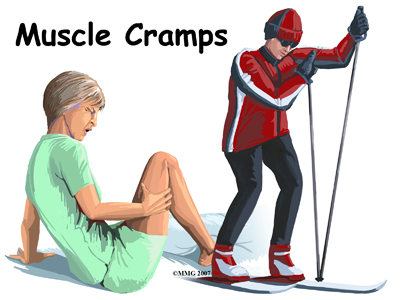
Welcome to Flex Motion Physical Therapy's patient resource about Muscle Cramps.
You have over 600 muscles in your body. These muscles control everything you do, from breathing to putting food in your mouth to swallowing.
When it comes to muscle cramps, the most commonly affected muscles are the muscles of your upper arms, the muscles behind your thighs, and the muscles in the front of your thighs.
This article will help you understand:
- what muscle cramps are
- how the problem develops
- what treatment options are available
- how muscle cramps can be prevented
Anatomy
What parts of the body are involved?
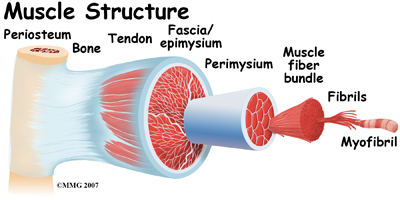
Muscles are composed of many fibers bundled together; the bigger, more frequently used muscles have more fibers than the smaller, lesser used ones. Among the muscles are voluntary and involuntary muscles. Voluntary, or striated muscles are those that we move by choice (for example, the muscles in your arms and legs). These muscles are attached to bones by tendons, a sinewy type of tissue. Involuntary muscles, or smooth muscles, are the ones that move on their own (for example, the muscles that control your diaphragm and help you breathe). The muscles in your heart are called involuntary cardiac muscles.
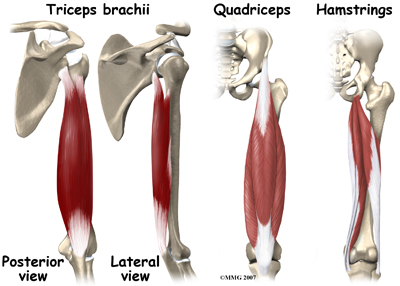
When it comes to muscle cramps, the most commonly affected muscles are the gastrocnemius (calf muscles), triceps (the muscles in your upper arms), the hamstrings (the muscles behind your thighs), and the quadriceps (the muscles in front of your thighs).
Causes
What causes muscle cramps?
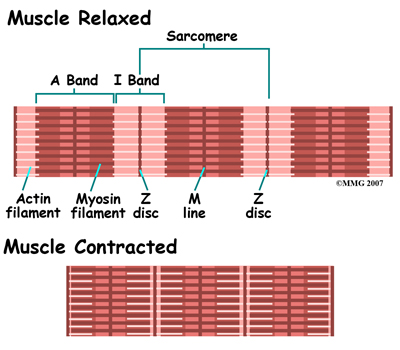
To move your muscles, your brain sends signals to the voluntary muscles and coordinates the movements that you want. The voluntary muscles contract as they're being used and they become tighter. The muscles then relax when the movement is complete. When the contraction/relaxation cycles are done repeatedly, as in exercising, the fibers become stronger and the muscles get larger and stronger. However, sometimes the muscles, or just a few fibers within the muscle, contract on their own, causing a muscle spasm or cramp. The difference between a spasm and a cramp is the force of the contraction. If it's a quick contraction and release of muscle, without pain, it's a spasm. If the contraction is prolonged and painful, it's a cramp. Occasionally, cramps are so intense that you can't use your muscle because it's so tight and painful. Cramps can be short-lived, a minute or less, or as long as a couple of days. When researchers tested the cramping muscles of some athletes, they found rapid repetitive muscle firing, which could be described as the muscle fibers being hyperactive, in a sense.
Cramps can happen in one muscle, like the hamstring, or they can happen in a number of muscles together, like in your hands if you have writer's cramp. They can happen once and then not again, or there can be a series of on-again-off-again cramping.
There are several reasons why muscle cramps may occur, including the most common one that is seen in both professional and weekend athletes. These are called exercise-associated muscle cramping or EAMC. These types of cramps fall under the category of paraphysiologic cramps. Those are cramps that affect normally healthy people but are brought on by an event, such as exercise.
Researchers have estimated that marathon runners and triathletes may have a 30 to 67 percent lifetime risk of developing these cramps. Although the exact cause of the cramping isn't known, researchers do believe that they can be caused by inadequate stretching, muscle fatigue, or lack of oxygen to the muscle. Other causes can also include heat, dehydration, and/or lack of salt and minerals (electrolytes). New research suggests that there may be abnormal motor neuron (nerve) activity at the level of the spine.
Researchers also have noticed that the athletes who suffer from a lot of cramping tend to be older, marathon runners, or have a high body mass index. They don't stretch regularly, and have a family history of muscle cramps.
Cramps can also happen if you use the same muscles in the same way for too long a period. This could be as you crouch down to work in the garden, type on a keyboard, or write out long lists with paper and pen. The muscles contract and cause the pain.
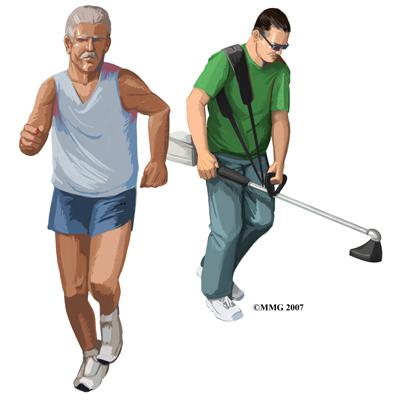
Occasionally, these types of cramps seemingly come out of nowhere. For example, as we stretch, we often point our toes downward. This motion contracts the muscle in the calf of the leg and can cause a severe cramp or charley horse.
Women who are pregnant may also find that they get more muscle cramps during their pregnancy, but the reason why isn't clear. Again, these are considered to be paraphysiologic cramps because they are brought on by the pregnancy. Along the same vein, seniors may also be prone to developing muscle cramps. Doctors believe this is due to loss of muscle mass as people age plus inactivity.
Muscle cramps can also occur as a side effect of medications. Diuretics, or water pills, cause you to eliminate fluid from your body. If too much fluid is eliminated too quickly, the resulting dehydration could cause muscle cramps. Other medications can also cause muscle cramps.
Skeletal problems can increase the chances of leg cramps. For example, people with problems like scoliosis (curvature of the spine) could have one leg longer than the other. This imbalance can cause cramping in the leg.
Symptomatic cramps are, as the name suggests, symptoms of an illness that may be causing the cramping. Examples of a few illnesses that can cause muscle cramping are: Parkinson's disease, tetanus, diabetes, and heart disease. Atherosclerosis (hardening of the arteries) makes it hard for blood to circulate throughout the body as it should. Often, one of the first signs of atherosclerosis is a symptom called claudication or intermittent claudication. Someone who has atherosclerosis may start feeling cramping in one or both legs after walking for a while. At rest, the pain disappears, but it comes back when the person resumes walking.
Radiculopathy (irritation of the nerve root at the spine) is a known cause for muscle cramping, usually at night. Some other illnesses that can cause muscle cramping are cirrhosis of the liver, Black Widow spider bites, and malignant hyperthermia, among others.
Finally, idiopathic muscle cramps are cramps that have no known cause but they are symptoms of a disease, or can be inherited. Sudden nocturnal (occurring at night) leg cramps are an example of this type of cramping.
Symptoms
What do muscle cramps feel like?
Muscle cramps are painful, there's no doubt about it. The symptoms of muscle cramps usually come on quickly and intensely. They can be so strong that you may have to stop what you're doing, the discomfort of the cramping making it too difficult to continue. There are also cramps that occur after the fact. These delayed or nocturnal cramps can affect athletes.
The most obvious symptom of a muscle cramp is a sharp, acute pain in the affected muscle or muscles. If it's a large muscle that is involved, like the one in the calf of your leg, you may be able to feel a knot or hard lump in the muscle, just under the skin.
Diagnosis
Generally, people know what they are experiencing when they have a muscle cramp so they don't seek medical help to find out what they are and what caused them. However, sometimes muscle cramps are more serious and they are frequent, lengthy, and unbearably painful. If they are caused by an illness, rather than overexertion, the reason for them will need to be found.
When you first visit Flex Motion Physical Therapy, our Physical Therapist will do a physical examination and take your medical history. Let us know if you have been ill recently with vomiting, diarrhea, or fever. Anything that may cause dehydration is important information and should be shared with our therapist.
We’ll ask when the cramps began, how long you been having them, how long they last, and what are you usually doing when they start. Other questions, such as are you pregnant, taking any medications (including over-the-counter and natural or herbal remedies), do you smoke, and how much alcohol do you drink, will be asked. Our therapist will also need to know how much and how often you exercise.
We will want to know exactly where the cramping is occurring. Let our Physical Therapist know if there are any other types of pain that happen at the same time. We will want to know if the cramps are always in the same place or if they occur elsewhere.
Some patients may be referred to a doctor for further diagnosis. Once your diagnostic examination is complete, the specialists at Flex Motion Physical Therapy can help.
Flex Motion Physical Therapy provides services for Physical Therapist in Glendale.
Physician Review
Further testing may be recommended. Blood tests are usually first since muscle cramping may be caused by dehydration and depletion of salt and minerals (electrolytes). Since pregnant women can be more prone to muscle cramping, a pregnancy test may be ordered for women along with other blood tests.
Additional blood tests may be ordered to check if your thyroid and kidneys are working properly. Your thyroid is a small gland that is just below your voice box and is responsible for making and distributing hormones.
If the blood tests are all within normal range and negative for pregnancy, there are more tests that may be ordered. A vascular Doppler ultrasound uses ultrasound waves to make images on a screen. Using the Doppler (small machine), your doctor looks to see if there are any blockages in the blood vessels.
If your doctor thinks there may be a neurological (nervous system), disorder causing the cramping. One test that may be done is called an electromyography (EMG). To perform an EMG, your doctor will insert a needle into the muscle that has been cramping. The needle has an electrode that will relay to a recording device any electrical activity from your muscle. After the needle has been inserted, you'll be asked to contract (flex, tighten) your muscle and then relax it.
A magnetic resonance imaging (MRI) scan may also be done. The MRI is a radiological test that uses magnetic waves and a computer to create pictures of the parts of the spine. To perform this test, you must lie in a tube for about an hour. No needles or dye are usually required. The machine takes pictures of the spine one slice at a time. It can do this in multiple directions. It allows the doctor to see the bones and soft tissues of the spine - including the nerves. Your doctor will be looking for anything that may show an injured disc, pinched nerve, or injured nerve that could represent a cause for the cramping.
Treatment
What can be done to relieve the pain from muscle cramps?
The type of treatments required for muscle cramps depends on what is causing them. If you're having occasional muscle cramps from physical activity or overusing certain muscles, you can usually take care of the cramps yourself. Simply stopping the activity will stop the cramping. If the cramps continue, stretching the cramping muscle - although painful - should release the tension of the muscle. For example, if it is your calf muscle that is cramping, stand facing a wall or solid object that you can hold on to for balance. Keeping your heel of the sore leg as close to the floor as possible, tilt your body (slowly) to the wall or object, stretching the calf muscle. If you're lying in bed when the cramping starts, you can try pointing your toes straight up towards the ceiling, or grab hold of your toes and pull your foot up towards you, keeping your knee bent slightly.
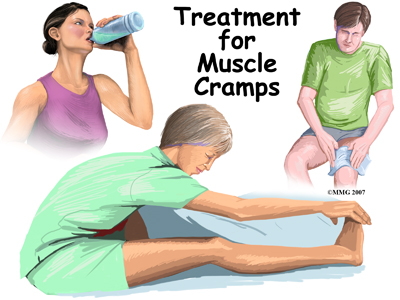
Some people find that using ice packs can help relax the tense muscles, others have better luck with heat such as from heating pads, warming packs, even warm towels. Be careful when applying ice or heat to a sore part of your body. Ice should never be held directly on the skin. Ice should always be buffered with at least one layer of cloth. Heating pads can get very warm and can cause burns, so be sure to monitor the heat level and keep a layer of fabric between the heat and the skin. Massage may help as well, although it can be painful as the knot is being worked out. If the cause of the cramping is dehydration, then fluids with electrolytes (sports drinks, for example) are essential to balance the fluid loss.
For athletes who experience a lot of cramping good nutrition is important. Adequate fluid and electrolytes may help limit the cramping. This could mean meeting with a dietitian to discuss diet and eating habits.
Some muscle cramps can be caused as a side effect of certain medications. Talk to your doctor. Adjusting the dosages or changing the medication may help the cramping problem. Don't change any of your prescription drugs or stop taking them without your doctor's knowledge and approval.
If the cramps are caused by an illness, they should subside by treating the illness. Medications are generally not recommended or used for muscle cramps because of their side effects. Most muscle cramps are short-lived. By the time the medication has started working the cramping has already stopped. There are some cases where doctors may use Botox to stop cramping in certain muscles. This is decided on an individual basis and depends on the cause and the impact of the cramping.
Because muscle cramps come on so quickly and suddenly, usually resolving just as fast as they came, the best treatment is prevention. Anyone who is about to do something strenuous or athletic should warm up and stretch their muscles first. If you're moving furniture, digging up a garden, painting, or doing general maintenance that you're not used to, the muscles you will be using can get fatigued. By warming up and stretching them, this should be prevented.
It's also important to stretch correctly. It is best to stretch after a muscle is already warmed up.Don't stretch quickly. Stretch slowly and hold each stretch for 30 seconds. Any shorter than 30 seconds and there's no benefit. Some experts suggest that athletes continue to stretch daily. This may keep the muscles flexible. Also remember to stretch after the activity to allow the muscles to cool down.
Other important tips include staying hydrated; drink enough fluids to keep your body's electrolytes from depleting - but don't overdo the fluids either. Finally, don't overdo the exercising, especially in hot weather.
Summary
Since exercise-associated muscle cramping occurs most often in healthy individuals, the important issue is to control cramping frequency and intensity. This can be done through preventative measures, such as proper preparation and stretching, and ensuring adequate fluid intake before undertaking physical exercise or activity.
For those who experience muscle cramps due to illness, their frequency and intensity may be affected by the treatment for the illness. If side effects from medication are causing the cramps, this may be avoided by changing or adjusting medications, dosage, or medication combinations when possible. Ask your doctor if a change in your prescription medication may help.
Portions of this document copyright MMG, LLC.











